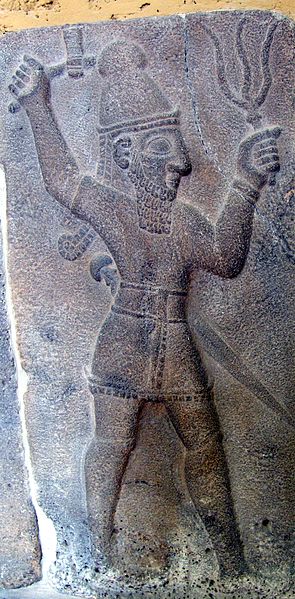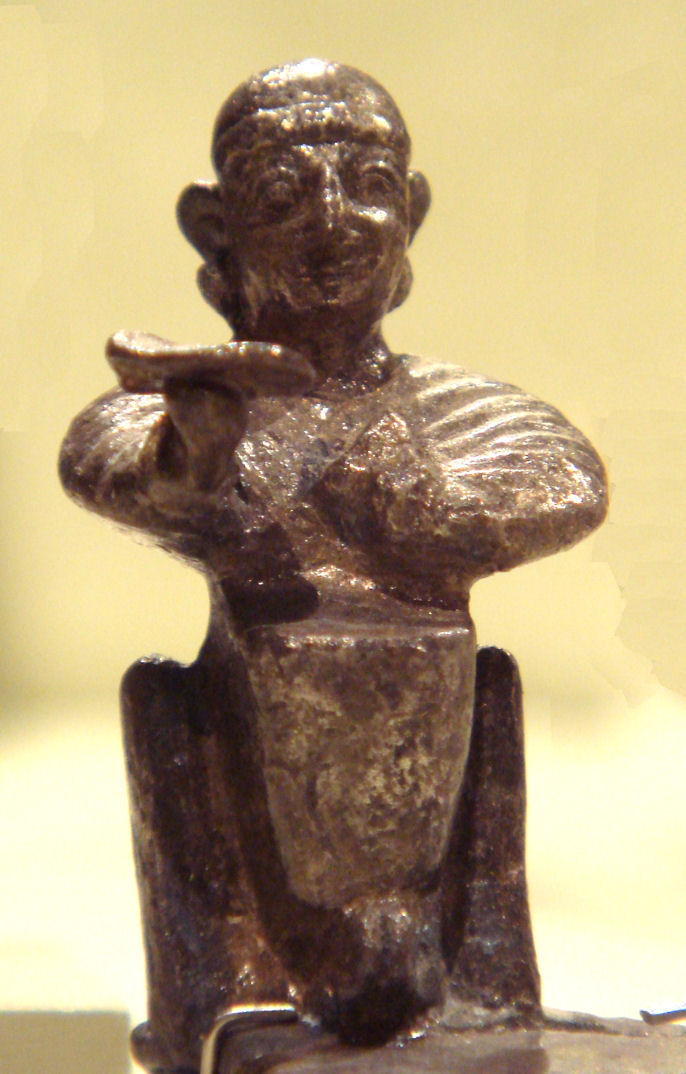|
Virgin Birth (mythology)
Stories of miraculous births often include conceptions by miraculous circumstances and features such as intervention by a deity, supernatural elements, astronomical signs, hardship or, in the case of some mythologies, complex plots related to creation. Near Eastern mythology The Assyrian and Babylonian concept of origins expressed procreation first in “relationships between gods and goddesses resulting in other gods and goddesses", such as Ea and Damkina assisted by Apsu giving birth to Marduk. The Akkadian '' Enûma Eliš'' describes the birth of Marduk as follows: "Ea, having overheard the plan of the primordial deities to destroy the other gods, deceived Apsu and Mummu and put them to death. 'Ea, his triumph over his enemies secured, in his sacred chamber in profound peace he rested.' (ANET, p. 61, lines 74—75.) Then he took over the place which Apsu had used for his cult and dwelt there with his spouse, Damkina." It was here that Marduk, the "most potent and wis ... [...More Info...] [...Related Items...] OR: [Wikipedia] [Google] [Baidu] |
Bel (god)
Bêl (; from akk, bēlu) is a title signifying "lord" or "master" applied to various gods in the Mesopotamian religion of Akkad, Assyria, and Babylonia. The feminine form is ''Bêlit'' ('Lady, Mistress') in Akkadian. ''Bel'' is represented in Greek as Belos and in Latin as Belus. ''Belit'' appears in Greek form as Beltis (Βελτις). Linguistically, ''Bel'' is an East Semitic form cognate with the Northwest Semitic Baal with the same meaning. ''Bel'' was especially used for the Babylonian god Marduk in Assyrian and neo-Babylonian personal names or mentioned in inscriptions in a Mesopotamian context. Similarly, ''Bêlit'' mostly refers to Marduk's spouse Sarpanit. Marduk's mother, the Sumerian goddess often referred to in the Sumerian language as Ninhursag, Damkina, and Ninmah, was often known as ''Belit-ili'' ("Lady of the Gods") in Akkadian. Other gods called "Lord" were sometimes identified totally or in part with Bel Marduk. The god Malak-bel of Palmyra is an ex ... [...More Info...] [...Related Items...] OR: [Wikipedia] [Google] [Baidu] |
Teshub
Teshub (also written Teshup, Teššup, or Tešup; cuneiform ; hieroglyphic Luwian , read as ''Tarhunzas'';Annick Payne (2014), ''Hieroglyphic Luwian: An Introduction with Original Texts'', 3rd revised edition, Wiesbaden: Harrassowitz Verlag, p. 159. Ugaritic 𐎚𐎘𐎁, ''TṮB'') was the Hurrian god of sky, thunder, and storms. Taru was the name of a similar Hattic storm god, whose mythology and worship as a primary deity continued and evolved through descendant Luwian and Hittite cultures. In these two, Taru was known as ''Tarhun / Tarhunt- / Tarhuwant- / Tarhunta'', names derived from the Anatolian root ''*tarh'' "to defeat, conquer". Taru/Tarhun/Tarhunt was ultimately assimilated into and identified with the Hurrian Teshub around the time of the religious reforms of Muwatalli II, ruler of the Hittite New Kingdom in the early 13th century BCE. [...More Info...] [...Related Items...] OR: [Wikipedia] [Google] [Baidu] |
Emasculation
Emasculation is the removal of both the penis and the testicles, the external male sex organs. It differs from castration, which is the removal of the testicles only, although the terms are sometimes used interchangeably. The potential medical consequences of emasculation are more extensive than those associated with castration, as the removal of the penis gives rise to a unique series of complications. There are a range of religious, cultural, punitive, and personal reasons why someone may choose to emasculate themselves or another person. Consensual emasculation may be seen as a form of body modification that enhances a recipient's identification with their community or sense of self. By comparison, non-consensual emasculations, such as those performed punitively or accidentally, may constitute genital mutilation. The medical treatment for an emasculated person differs depending on whether the procedure was consensual. The term ''emasculation'' may be used metaphorically to r ... [...More Info...] [...Related Items...] OR: [Wikipedia] [Google] [Baidu] |
Johns Hopkins University Press
The Johns Hopkins University Press (also referred to as JHU Press or JHUP) is the publishing division of Johns Hopkins University. It was founded in 1878 and is the oldest continuously running university press in the United States. The press publishes books and journals, and operates other divisions including fulfillment and electronic databases. Its headquarters are in Charles Village, Baltimore. In 2017, after the retirement of Kathleen Keane who is credited with modernizing JHU Press for the digital age, the university appointed new director Barbara Pope. Overview Daniel Coit Gilman, the first president of the Johns Hopkins University, inaugurated the press in 1878. The press began as the university's Publication Agency, publishing the ''American Journal of Mathematics'' in its first year and the ''American Chemical Journal'' in its second. It published its first book, ''Sidney Lanier: A Memorial Tribute'', in 1881 to honor the poet who was one of the university's first writers ... [...More Info...] [...Related Items...] OR: [Wikipedia] [Google] [Baidu] |
Kumarbi
Kumarbi was an important god of the Hurrians, regarded as "the father of gods." He was also a member of the Hittite pantheon. According to Hurrian myths, he was a son of Alalu, and one of the parents of the storm-god Teshub, the other being Anu (the Mesopotamian sky god). His cult city was Urkesh. Syncretism God lists from Ugarit equate Kumarbi with the Mesopotamian Enlil and the local El; other sources equate him with the Syrian Dagan as well, and he was even called "the Dagan of the Hurrians." It's also been proposed that a Hurro-Akkadian god list from Emar equates Ishtaran with him for uncertain reasons. Due to particularly close syncretism between Dagan and Kumarbi due to their shared role as "fathers of gods" in Syria, Dagan's wife Shalash was also viewed as his spouse, though he has other consorts in myths: an unnamed mortal woman and Sertapsuruhi, daughter of the sea god. Kumarbi cycle Kumarbi is known from a number of mythological texts, sometimes summarized unde ... [...More Info...] [...Related Items...] OR: [Wikipedia] [Google] [Baidu] |
Hittite Mythology
Hittite mythology and Hittite religion were the religious beliefs and practices of the Hittites, who created an empire centered in what is now Turkey from . Most of the narratives embodying Hittite mythology are lost, and the elements that would give a balanced view of Hittite religion are lacking among the tablets recovered at the Hittite capital Hattusa and other Hittite sites. Thus, "there are no canonical scriptures, no theological disquisitions or discourses, no aids to private devotion". Some religious documents formed part of the corpus with which young scribes were trained, and have survived, most of them dating from the last several decades before the final burning of the sites. The scribes in the royal administration, some of whose archives survive, were a bureaucracy, organizing and maintaining royal responsibilities in areas that would be considered part of religion today: temple organization, cultic administration, reports of diviners, make up the main body of sur ... [...More Info...] [...Related Items...] OR: [Wikipedia] [Google] [Baidu] |
The Westminster Press
''The'' () is a grammatical article in English, denoting persons or things already mentioned, under discussion, implied or otherwise presumed familiar to listeners, readers, or speakers. It is the definite article in English. ''The'' is the most frequently used word in the English language; studies and analyses of texts have found it to account for seven percent of all printed English-language words. It is derived from gendered articles in Old English which combined in Middle English and now has a single form used with pronouns of any gender. The word can be used with both singular and plural nouns, and with a noun that starts with any letter. This is different from many other languages, which have different forms of the definite article for different genders or numbers. Pronunciation In most dialects, "the" is pronounced as (with the voiced dental fricative followed by a schwa) when followed by a consonant sound, and as (homophone of pronoun ''thee'') when followed by a v ... [...More Info...] [...Related Items...] OR: [Wikipedia] [Google] [Baidu] |
Dusares
Dushara, (Nabataean Arabic: 𐢅𐢈𐢝𐢛𐢀 ''dwšrʾ'') also transliterated as Dusares, is a pre-Islamic Arabian god worshipped by the Nabataeans at Petra and Madain Saleh (of which city he was the patron). Safaitic inscriptions imply he was the son of Al-Lat, and that he assembled in the heavens with other gods. He is called "Dushara from Petra" in one inscription. Dushara was expected to bring justice if called by the correct ritual. Etymology Dushara is known first from epigraphic Nabataean sources who invariably spell the name ''dwsrʾ'', the Nabataean script denoting only consonants. He appears in Classical Greek sources Δουσάρης (''Dousárēs'') and in Latin as ''Dusares''. The original meaning is disputed, but early Muslim historian Ibn al-Kalbi in his "Book of Idols" explains the name as ''Dhū l-Šarā'' ( ar, ذو الشرى), meaning likely "The One from Shara", Shara being a mountain range south-east of the Dead Sea. If this interpretation is correct, ... [...More Info...] [...Related Items...] OR: [Wikipedia] [Google] [Baidu] |
Assur
Aššur (; Sumerian: AN.ŠAR2KI, Assyrian cuneiform: ''Aš-šurKI'', "City of God Aššur"; syr, ܐܫܘܪ ''Āšūr''; Old Persian ''Aθur'', fa, آشور: ''Āšūr''; he, אַשּׁוּר, ', ar, اشور), also known as Ashur and Qal'at Sherqat, was the capital of the Old Assyrian city-state (2025–1364 BC), the Middle Assyrian Empire (1363–912 BC), and for a time, of the Neo-Assyrian Empire (911–609 BC). The remains of the city lie on the western bank of the Tigris River, north of the confluence with its tributary, the Little Zab, in what is now Iraq, more precisely in the al-Shirqat District of the Saladin Governorate. Occupation of the city itself continued for approximately 4,000 years, from the Early Dynastic Period to the mid-14th century AD, when the forces of Timur massacred its predominately Christian population. The site is a World Heritage Site, having been added to that organisation's list of sites in danger in 2003 following the conflict that erupt ... [...More Info...] [...Related Items...] OR: [Wikipedia] [Google] [Baidu] |
Sennacherib
Sennacherib (Neo-Assyrian cuneiform: or , meaning " Sîn has replaced the brothers") was the king of the Neo-Assyrian Empire from the death of his father Sargon II in 705BC to his own death in 681BC. The second king of the Sargonid dynasty, Sennacherib is one of the most famous Assyrian kings for the role he plays in the Hebrew Bible, which describes his campaign in the Levant. Other events of his reign include his destruction of the city of Babylon in 689BC and his renovation and expansion of the last great Assyrian capital, Nineveh. Although Sennacherib was one of the most powerful and wide-ranging Assyrian kings, he faced considerable difficulty in controlling Babylonia, which formed the southern portion of his empire. Many of Sennacherib's Babylonian troubles stemmed from the Chaldean tribal chief Marduk-apla-iddina II, who had been Babylon's king until Sennacherib's father defeated him. Shortly after Sennacherib inherited the throne in 705BC, Marduk-apla-idd ... [...More Info...] [...Related Items...] OR: [Wikipedia] [Google] [Baidu] |
Sin (mythology)
Nanna, Sīn or Suen ( akk, ), and in Aramaic ''syn'', ''syn’'', or even ''shr'' 'moon', or Nannar ( sux, ) was the god of the moon in the Mesopotamian religions of Sumer, Akkad, Assyria, Babylonia and Aram. He was also associated with cattle, perhaps due to the perceived similarity between bull horns and the crescent moon. He was always described as a major deity, though only a few sources, mostly these from the reign of Nabonidus, consider him to be the head of the Mesopotamian pantheon. The two chief seats of his worship were Ur in the south of Mesopotamia and Harran in the north, though he was also worshiped in numerous other cities, especially in the proximity of Ur and in the Diyala area. In Ur, he was connected to royal power, and many Mesopotamian kings visited his temple in this city. According to Mesopotamian mythology, his parents were Enlil and Ninlil, while his wife was Ningal, worshiped with him in his major cult centers. Their children included major ... [...More Info...] [...Related Items...] OR: [Wikipedia] [Google] [Baidu] |





.png)

